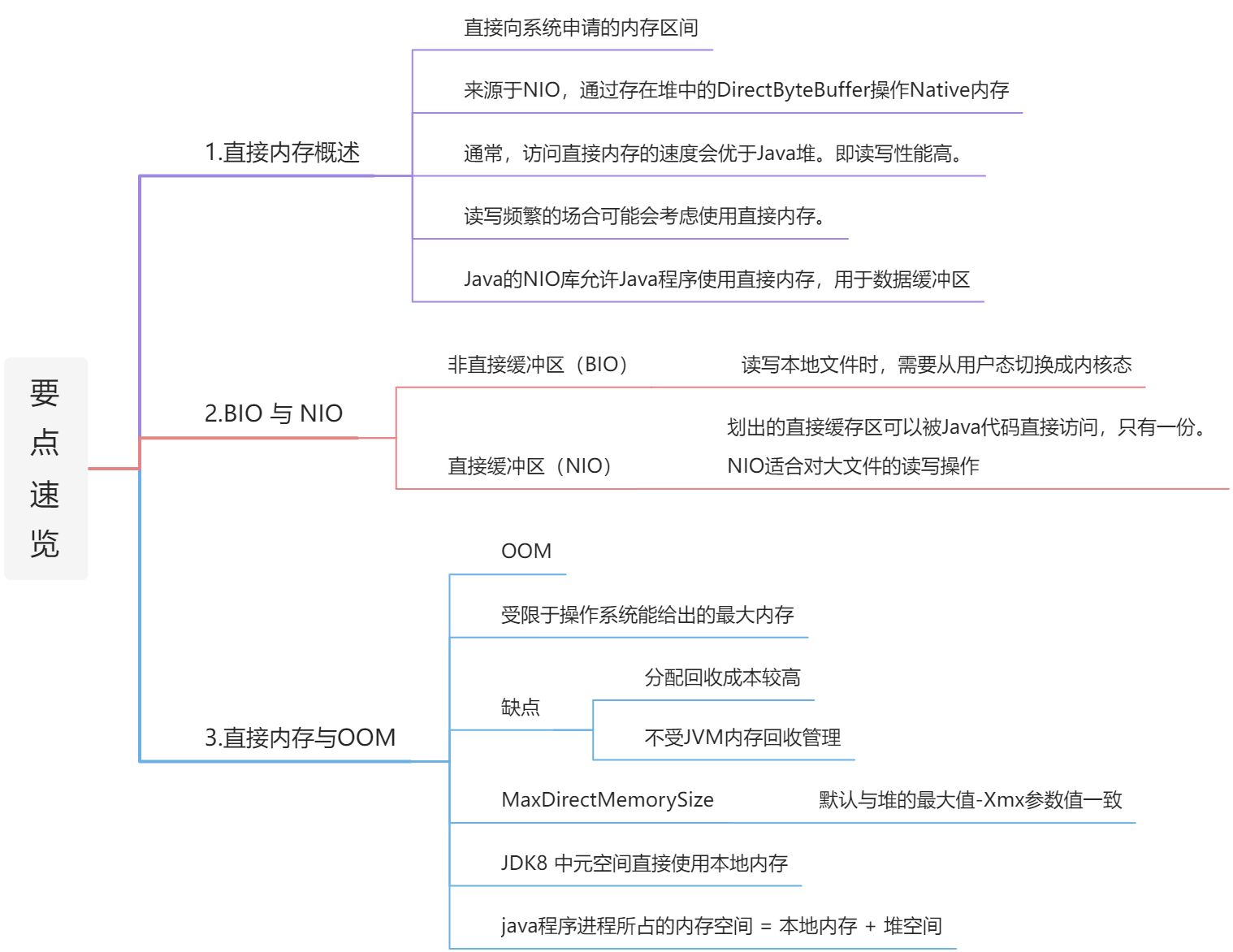
查看详细思维导图及更好的文档排版请访问语雀:第11章 - 直接内存
文章目录
参考文章: https://blog.csdn.net/sj15814963053/article/details/110393383?spm=1001.2014.3001.5502
1.直接内存概述
- 不是虚拟机运行时数据区的一部分,也不是《Java虚拟机规范》中定义的内存区域。
- 直接内存是在Java堆外的、直接向系统申请的内存区间。
- 来源于NIO,通过存在堆中的DirectByteBuffer操作Native内存
- 通常,访问直接内存的速度会优于Java堆。即读写性能高。
- 因此出于性能考虑,读写频繁的场合可能会考虑使用直接内存。
- Java的NIO库允许Java程序使用直接内存,用于数据缓冲区
/**
* IO NIO (New IO / Non-Blocking IO)
* byte[] / char[] Buffer
* Stream Channel
*
* 查看直接内存的占用与释放
*/
public class BufferTest {
private static final int BUFFER = 1024 * 1024 * 1024; //1GB
public static void main(String[] args){
//直接分配本地内存空间
ByteBuffer byteBuffer = ByteBuffer.allocateDirect(BUFFER);
System.out.println("直接内存分配完毕,请求指示!");
Scanner scanner = new Scanner(System.in);
scanner.next();
System.out.println("直接内存开始释放!");
byteBuffer = null;
System.gc();
scanner.next();
}
}

释放后,Java程序的内存占用明显减少
2.BIO 与 NIO
非直接缓冲区(BIO)
原来采用BIO的架构,在读写本地文件时,我们需要从用户态切换成内核态
直接缓冲区(NIO)
使用NIO时,如下图。操作系统划出的直接缓存区可以被Java代码直接访问,只有一份。NIO适合对大文件的读写操作
public class BufferTest1 {
private static final String TO = "F:\\test\\异界BD中字.mp4";
private static final int _100Mb = 1024 * 1024 * 100;
public static void main(String[] args) {
long sum = 0;
String src = "F:\\test\\异界BD中字.mp4";
for (int i = 0; i < 3; i++) {
String dest = "F:\\test\\异界BD中字_" + i + ".mp4";
// sum += io(src,dest); //54606
sum += directBuffer(src, dest); //50244
}
System.out.println("总花费的时间为:" + sum);
}
private static long directBuffer(String src, String dest) {
long start = System.currentTimeMillis();
FileChannel inChannel = null;
FileChannel outChannel = null;
try {
inChannel = new FileInputStream(src).getChannel();
outChannel = new FileOutputStream(dest).getChannel();
ByteBuffer byteBuffer = ByteBuffer.allocateDirect(_100Mb);
while (inChannel.read(byteBuffer) != -1) {
byteBuffer.flip(); //修改为读数据模式
outChannel.write(byteBuffer);
byteBuffer.clear(); //清空
}
} catch (IOException e) {
e.printStackTrace();
} finally {
if (inChannel != null) {
try {
inChannel.close();
} catch (IOException e) {
e.printStackTrace();
}
}
if (outChannel != null) {
try {
outChannel.close();
} catch (IOException e) {
e.printStackTrace();
}
}
}
long end = System.currentTimeMillis();
return end - start;
}
private static long io(String src, String dest) {
long start = System.currentTimeMillis();
FileInputStream fis = null;
FileOutputStream fos = null;
try {
fis = new FileInputStream(src);
fos = new FileOutputStream(dest);
byte[] buffer = new byte[_100Mb];
while (true) {
int len = fis.read(buffer);
if (len == -1) {
break;
}
fos.write(buffer, 0, len);
}
} catch (IOException e) {
e.printStackTrace();
} finally {
if (fis != null) {
try {
fis.close();
} catch (IOException e) {
e.printStackTrace();
}
}
if (fos != null) {
try {
fos.close();
} catch (IOException e) {
e.printStackTrace();
}
}
}
long end = System.currentTimeMillis();
return end - start;
}
}
深入 ByteBuffer 源码
ByteBuffer.allocateDirect( ) 方法
public static ByteBuffer allocateDirect(int capacity) {
return new DirectByteBuffer(capacity);
}
DirectByteBuffer 类的构造器用到了 Unsafe 类分配本地内存
DirectByteBuffer(int cap) { // package-private
super(-1, 0, cap, cap);
boolean pa = VM.isDirectMemoryPageAligned();
int ps = Bits.pageSize();
long size = Math.max(1L, (long)cap + (pa ? ps : 0));
Bits.reserveMemory(size, cap);
long base = 0;
try {
base = unsafe.allocateMemory(size);
} catch (OutOfMemoryError x) {
Bits.unreserveMemory(size, cap);
throw x;
}
unsafe.setMemory(base, size, (byte) 0);
if (pa && (base % ps != 0)) {
// Round up to page boundary
address = base + ps - (base & (ps - 1));
} else {
address = base;
}
cleaner = Cleaner.create(this, new Deallocator(base, size, cap));
att = null;
}
3.直接内存与OOM
- 直接内存也可能导致OutofMemoryError异常
- 由于直接内存在Java堆外,因此它的大小不会直接受限于-Xmx指定的最大堆大小,但是系统内存是有限的,Java堆和直接内存的总和依然受限于操作系统能给出的最大内存。
- 直接内存的缺点为:
- 分配回收成本较高
- 不受JVM内存回收管理
- 直接内存大小可以通过
MaxDirectMemorySize设置 - 如果不指定,默认与堆的最大值-Xmx参数值一致
/**
* 本地内存的OOM: OutOfMemoryError: Direct buffer memory
*/
public class BufferTest2 {
private static final int BUFFER = 1024 * 1024 * 20; //20MB
public static void main(String[] args) {
ArrayList<ByteBuffer> list = new ArrayList<>();
int count = 0;
try {
while(true){
ByteBuffer byteBuffer = ByteBuffer.allocateDirect(BUFFER);
list.add(byteBuffer);
count++;
try {
Thread.sleep(100);
} catch (InterruptedException e) {
e.printStackTrace();
}
}
} finally {
System.out.println(count);
}
}
}
本地内存持续增长,直至程序抛出异常:java.lang.OutOfMemoryError: Direct buffer memory
代码示例2:直接通过 Unsafe 类申请本地内存
/**
* -Xmx20m -XX:MaxDirectMemorySize=10m
*/
public class MaxDirectMemorySizeTest {
private static final long _1MB = 1024 * 1024;
public static void main(String[] args) throws IllegalAccessException {
Field unsafeField = Unsafe.class.getDeclaredFields()[0];
unsafeField.setAccessible(true);
Unsafe unsafe = (Unsafe)unsafeField.get(null);
while(true){
unsafe.allocateMemory(_1MB);
}
}
}
设置JVM 参数 -Xmx20m -XX:MaxDirectMemorySize=10m
抛出 OOM 异常
JDK8 中元空间直接使用本地内存
java程序进程所占的内存空间 = 本地内存 + 堆空间






















 1083
1083











 被折叠的 条评论
为什么被折叠?
被折叠的 条评论
为什么被折叠?








